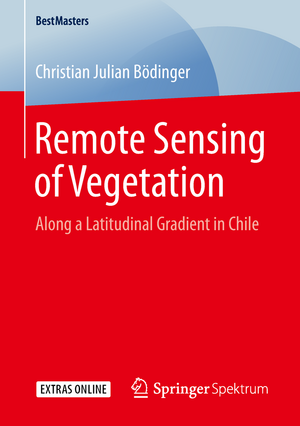Remote Sensing of Vegetation: Along a Latitudinal Gradient in Chile: BestMasters
Autor Christian Julian Bödingeren Limba Engleză Paperback – 5 feb 2019
About the Author:
Christian Bödinger holds a M.Sc. in Physical Geography from the University of Tübingen, Germany. His focus in research lies on remote sensing and image analysis for environmental applications. He is currently working for a company focusing on aquatic remote sensing.
Christian Bödinger holds a M.Sc. in Physical Geography from the University of Tübingen, Germany. His focus in research lies on remote sensing and image analysis for environmental applications. He is currently working for a company focusing on aquatic remote sensing.
Din seria BestMasters
-
 Preț: 362.32 lei
Preț: 362.32 lei - 13%
 Preț: 367.41 lei
Preț: 367.41 lei -
 Preț: 364.14 lei
Preț: 364.14 lei - 5%
 Preț: 403.96 lei
Preț: 403.96 lei -
 Preț: 377.18 lei
Preț: 377.18 lei -
 Preț: 367.05 lei
Preț: 367.05 lei - 13%
 Preț: 364.57 lei
Preț: 364.57 lei - 13%
 Preț: 366.14 lei
Preț: 366.14 lei - 13%
 Preț: 368.35 lei
Preț: 368.35 lei -
 Preț: 391.41 lei
Preț: 391.41 lei - 13%
 Preț: 367.41 lei
Preț: 367.41 lei -
 Preț: 311.76 lei
Preț: 311.76 lei -
 Preț: 396.86 lei
Preț: 396.86 lei -
 Preț: 406.59 lei
Preț: 406.59 lei -
 Preț: 365.66 lei
Preț: 365.66 lei -
 Preț: 394.31 lei
Preț: 394.31 lei - 13%
 Preț: 365.83 lei
Preț: 365.83 lei - 13%
 Preț: 396.42 lei
Preț: 396.42 lei - 20%
 Preț: 366.22 lei
Preț: 366.22 lei -
 Preț: 364.14 lei
Preț: 364.14 lei -
 Preț: 367.05 lei
Preț: 367.05 lei -
 Preț: 346.23 lei
Preț: 346.23 lei -
 Preț: 365.59 lei
Preț: 365.59 lei -
 Preț: 392.13 lei
Preț: 392.13 lei -
 Preț: 251.34 lei
Preț: 251.34 lei - 20%
 Preț: 292.10 lei
Preț: 292.10 lei -
 Preț: 404.05 lei
Preț: 404.05 lei -
 Preț: 393.58 lei
Preț: 393.58 lei -
 Preț: 393.58 lei
Preț: 393.58 lei -
 Preț: 344.87 lei
Preț: 344.87 lei -
 Preț: 410.77 lei
Preț: 410.77 lei -
 Preț: 411.75 lei
Preț: 411.75 lei -
 Preț: 379.30 lei
Preț: 379.30 lei -
 Preț: 411.32 lei
Preț: 411.32 lei -
 Preț: 412.89 lei
Preț: 412.89 lei -
 Preț: 377.73 lei
Preț: 377.73 lei -
 Preț: 378.12 lei
Preț: 378.12 lei -
 Preț: 412.51 lei
Preț: 412.51 lei -
 Preț: 481.79 lei
Preț: 481.79 lei -
 Preț: 377.18 lei
Preț: 377.18 lei -
 Preț: 480.06 lei
Preț: 480.06 lei -
 Preț: 376.04 lei
Preț: 376.04 lei -
 Preț: 382.95 lei
Preț: 382.95 lei -
 Preț: 377.95 lei
Preț: 377.95 lei -
 Preț: 412.68 lei
Preț: 412.68 lei -
 Preț: 376.80 lei
Preț: 376.80 lei -
 Preț: 380.45 lei
Preț: 380.45 lei -
 Preț: 410.17 lei
Preț: 410.17 lei -
 Preț: 410.94 lei
Preț: 410.94 lei -
 Preț: 380.63 lei
Preț: 380.63 lei
Preț: 377.57 lei
Nou
Puncte Express: 566
Preț estimativ în valută:
72.25€ • 77.26$ • 60.24£
72.25€ • 77.26$ • 60.24£
Carte tipărită la comandă
Livrare economică 17 aprilie-01 mai
Preluare comenzi: 021 569.72.76
Specificații
ISBN-13: 9783658251192
ISBN-10: 3658251190
Pagini: 108
Ilustrații: XXIII, 108 p. 1 illus.
Dimensiuni: 148 x 210 mm
Greutate: 0.17 kg
Ediția:1st ed. 2019
Editura: Springer Fachmedien Wiesbaden
Colecția Springer Spektrum
Seria BestMasters
Locul publicării:Wiesbaden, Germany
ISBN-10: 3658251190
Pagini: 108
Ilustrații: XXIII, 108 p. 1 illus.
Dimensiuni: 148 x 210 mm
Greutate: 0.17 kg
Ediția:1st ed. 2019
Editura: Springer Fachmedien Wiesbaden
Colecția Springer Spektrum
Seria BestMasters
Locul publicării:Wiesbaden, Germany
Cuprins
TanDEM-X DEM, Sentinel Optical and Radar Data, Landsat Surface Reflectance.- Machine Learning Using SVMs and Random Forest.- Statistical Time-Series Evaluation.- Maps of Land Use and Cover (LULC).- Time-Series Showing the Impact of ENSO.
Notă biografică
Christian Bödinger holds a M.Sc. in Physical Geography from the University of Tübingen, Germany. His focus in research lies on remote sensing and image analysis for environmental applications. He is currently working for a company focusing on aquatic remote sensing.
Textul de pe ultima copertă
How is the vegetation distribution influencing the erosion and surface formation in the different eco zones of Chile? To answer this question, it is mandatory to possess fundamental knowledge about plant species habitats, occurrence and their dynamics. In his study Christian Bödinger utilizes satellite imagery in combination with machine learning to derive maps of land use and land cover (LULC) in four study sites along a climatic gradient and to monitor vegetation using monthly Normalized Difference Vegetation Index (NDVI) time series. The findings contribute to a better understanding of climate impacts on Chilean vegetation and serve as a basis of landscape evolution models.
Contents
- TanDEM-X DEM, Sentinel Optical and Radar Data, Landsat Surface Reflectance
- Machine Learning Using SVMs and Random Forest
- Statistical Time-Series Evaluation
- Maps of Land Use and Cover (LULC)
- Time-SeriesShowing the Impact of ENSO
Target Groups
- Scientists, lecturers and students in the field of geology and ecology
- Geoscientists and Ecologists with a focus on remote sensing
About the Author
Christian Bödinger holds a M.Sc. in Physical Geography from the University of Tübingen, Germany. His focus in research lies on remote sensing and image analysis for environmental applications. He is currently working for a company focusing on aquatic remote sensing.
Caracteristici
A better understanding of climate impacts
